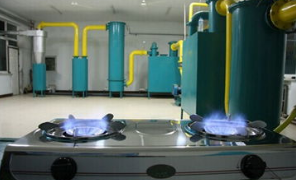(1)脫H2O
脫H2O是因為導氣管中如果積累了水會溶解H2S腐蝕管道,此外當沼氣被加壓儲存時,沼氣中的水會凝結凍壞儲氣罐。發酵裝置出來的沼氣中所含的水分形式是飽和水蒸氣,一般采用冷分離法將其除去。通過調整壓力引起混合氣體溫度發生變化,使水蒸氣從氣態冷凝為液態的水后,將其從沼氣中脫除。此法經濟簡單,被大多數沼氣工程所采用。
沼氣冷卻的方式有自然降溫及機械脫水兩種。冷卻溫度還要考慮下一步脫硫過程中不同脫硫劑對水分量的要求,根據脫硫劑的水分合理量進行適當的初步冷卻。
在沼氣輸送過程中,還有一部分水要析出。為了避免析出的水分腐蝕或堵塞管道,常在管路的低處安裝集水器,定期排除集水器中的水。

(1) H2O removal
H2O removal is due to the fact that H2S will dissolve and corrode the pipeline if water accumulates in the air duct. In addition, when methane is stored under pressure, the water in the methane will condense and freeze the air storage tank. The form of moisture contained in biogas from fermentation unit is saturated steam, which is generally removed by cold separation method. The temperature of the mixed gas is changed by adjusting the pressure, so that water vapor is condensed into liquid water from a gaseous state and then removed from biogas. This method is economical and simple, and is adopted by most biogas projects.
There are two ways of methane cooling: natural cooling and mechanical dehydration. The cooling temperature should also consider the water content requirements of different desulfurizers in the next desulfurization process, and appropriate preliminary cooling should be carried out according to the reasonable water content of the desulfurizer.
In the process of biogas transportation, there is still some water to be separated out. In order to prevent the precipitated water from corroding or blocking the pipeline, a water collector is often installed at the lowest part of the pipeline, and the water in the water collector is regularly drained.
(2)脫H2S
脫H2S是為了避免H2S腐蝕設備、H2S中毒和如果沼氣燃燒H2S被氧化成SO2或SO3造成更大的危害。
總結出來的8種H2S脫除方法可以分為物理提純、化學凈化和生物吸收。現就3種機理中常用的方法分析如下。
① 活性炭吸附工藝。在變壓吸附系統中H2S可以通過用KI浸泡過的活性炭去除。此過程中,H2S被轉化為單質S和H2O,單質S就被活性炭吸收了。在連續運行的情況下,系統要包含兩個吸附裝置。如果活性炭上H2S的濃度超過3ppm,需要進行再生。
② 氧化鐵吸收工藝。通過氧化鐵來吸收沼氣中的H2S,此工藝的脫硫原理如下:
Fe2O3?H2O+H2→Fe2S3?H2O+3H2O
(1)此反應是放熱反應,低溫度要求12℃,佳反應溫度為25℃~50℃。所以,實際工程運營中,需要加熱來達到佳反應溫度。另外,H2S的脫除是通過在活性氧化鐵表面的水膜中離解成H+和S2+后,再進行化學反應。因為此反應需要一定量的水,一般要將脫硫劑的水分含量控制在10%~15%。所以沼氣在前面的脫水過程中溫度不能太低,水分不能脫除得太多,但也應避免生成的冷凝水使球狀氧化鐵粘在一起,減少了反應表面,從而影響脫硫效果。
此法的脫硫工藝中產生的硫化鐵可以被空氣氧化再生,生成氧化鐵和單質S。此工藝的反應原理如下,
Fe2S3?H2O+3/2O2→Fe2O3+3S+609kJ
(2)從反應式可以看出,再生過程中會放出大量的熱,因此常常會發生自燃。為防止脫硫劑自燃,一般需要對卸除的廢脫硫劑噴灑少量水。另外,在經過很多次重復使用后,氧化鐵的表面上會覆蓋一層硫單質,所以就需要更換氧化鐵。通常一個裝置中要配有兩個反應床,一個進行脫硫時,另一個可以進行再生。
在目前的畜禽養殖場沼氣工程中,氧化鐵吸收工藝被稱為干法脫硫。另外有一種常用的濕法脫硫。濕法脫硫的脫硫劑多用濃度為2%~3%的碳酸鈉溶液。此兩方法的脫硫劑都可以再生。
③ 生物脫硫法。該法是利用無色硫細菌,如氧化硫硫桿菌、氧化亞鐵硫桿菌等,在一定的溫度、濕度和微氧的條件下,將H2S氧化成單質S或H2SO3。脫硫機理為:①H2S氣體溶解,即由氣相轉化為液相;②溶解后的H2S被微生物吸收,轉移至微生物體內;③進入微生物細胞內的H2S作為營養物被微生物分解、轉化和利用,從而達到去除H2S的目的。其反應方程式如下:
2H2S+3O2→2H2SO3
2H2S+ O2→2S+2H2O
大部分的硫氧化細菌都屬于硫桿菌屬。硫桿菌隨處可見,用來脫除H2S并不需要接種。另外,大多硫桿菌是自養的,厭氧消化物的表面可以提供給它們一個生長所需的微觀好氧環境和必需的營養。所以,運用生物法脫硫,直接往厭氧消化罐或儲氣罐中通入一定量的O2或空氣并保持一定時間即可,方法比較簡單。適當的溫度、反應時間和空氣量可以使沼氣中的H2S含量減少至50ppm。
在實際運用中,沼氣中通入O2或空氣的量根據沼氣中H2S的含量確定,一般為2%~6%的空氣。對于不同甲烷含量的沼氣,空氣中的爆炸范圍不同,所以必需采取一定的安全措施避免沼氣中通入過量的空氣引起爆炸。同時,生物脫硫也存在過程不容易控制、脫除出來的單質S容易堵塞填料及損害曝氣頭等缺點。
(2) H2S removal
H2S removal is to avoid H2S corrosion of equipment, H2S poisoning and greater harm if H2S is oxidized to SO2 or SO3 during biogas combustion.
The eight H2S removal methods summarized can be divided into physical purification, chemical purification and biological absorption. Now, the methods commonly used in the three mechanisms are analyzed as follows.
(1) activated carbon adsorption process. H2S can be removed by activated carbon soaked with KI in pressure swing adsorption system. In this process, H2S is converted into elemental S and H2O, and elemental S is absorbed by activated carbon. Under the condition of continuous operation, the system should include two adsorption devices. If the concentration of H2S on activated carbon exceeds 3ppm, regeneration is required.
(2) iron oxide absorption process. The H2S in biogas is absorbed by ferric oxide. The desulfurization principle of this process is as follows:
Fe2O3? H2O+H2→Fe2S3? H2O+3H2O
(1) this reaction is exothermic, the minimum temperature is 12℃, and the optimal reaction temperature is 25℃ ~ 50℃. Therefore, in actual engineering operation, heating is required to reach the optimal reaction temperature. In addition, H2S removal is carried out by dissociating into H+ and S2+ in the water film on the surface of active iron oxide, and then carrying out chemical reaction. Because this reaction requires a certain amount of water, the moisture content of the desulfurizing agent is generally controlled at 10% ~ 15%. Therefore, the temperature of biogas in the previous dehydration process cannot be too low and the moisture cannot be removed too much, but the condensed water generated should also be avoided to make spherical iron oxide stick together, reducing the reaction surface and thus affecting the desulfurization effect.
Iron sulfide produced in the desulfurization process of this method can be oxidized and regenerated by air to produce iron oxide and elemental S .. The reaction principle of this process is as follows.
Fe2S3? H2O+3/2O2→Fe2O3+3S+609kJ
(2) As can be seen from the reaction formula, a large amount of heat will be released during regeneration, so spontaneous combustion often occurs. In order to prevent the desulfurizer from spontaneous combustion, it is generally necessary to spray a small amount of water on the discharged waste desulfurizer. In addition, after repeated use for many times, the surface of iron oxide will be covered with a layer of elemental sulfur, so it is necessary to replace iron oxide. Usually one unit is equipped with two reaction beds, one for desulfurization and the other for regeneration.
In the current biogas project of livestock and poultry farms, iron oxide absorption process is called dry desulfurization. In addition, there is a common wet desulfurization method. The desulfurizer for wet desulfurization is mostly sodium carbonate solution with concentration of 2% ~ 3%. The desulfurizer of both methods can be regenerated.
(3) biological desulfurization method. The method uses colorless sulfur bacteria, such as thiobacillus thiooxidans and thiobacillus ferrooxidans, to oxidize H2S into elemental S or H2SO3 under certain temperature, humidity and micro-oxygen conditions. The desulfurization mechanism is as follows: ①H2S gas dissolves, i.e. changes from gas phase to liquid phase; (2) Dissolved H2S is absorbed by microorganisms and transferred to microorganisms; (3) H2S entering microbial cells is decomposed, transformed and utilized by microorganisms as nutrients, thus achieving the purpose of H2S removal. The reaction equation is as follows:
2H2S+3O2→2H2SO3
2H2S+ O2→2S+2H2O
Most sulfur oxidizing bacteria belong to the genus Thiobacillus. Thiobacillus can be found everywhere, and inoculation is not required for H2S removal. In addition, most thiobacilli are autotrophic, and the surface of anaerobic digests can provide them with a micro aerobic environment and necessary nutrition for growth. Therefore, it is simple to apply biological desulfurization by directly introducing a certain amount of O2 or air into the anaerobic digestion tank or gas storage tank and keeping it for a certain period of time. Proper temperature, reaction time and air volume can reduce H2S content in biogas to 50ppm.
In actual application, the amount of O2 or air introduced into the biogas is determined according to the H2S content in the biogas, which is generally 2% ~ 6% air. For methane with different methane content, the explosion range in the air is different, so certain safety measures must be taken to prevent methane from introducing excessive air to cause explosion. At the same time, biological desulfurization also has the disadvantages that the process is not easy to control, the removed elemental S is easy to block the filler and damage the aeration, etc.
生物脫硫,沼氣脫硫,
沼氣提純問題請點擊了解。
